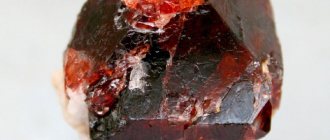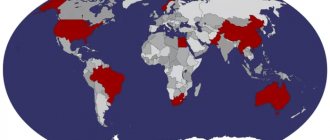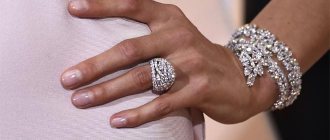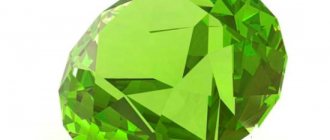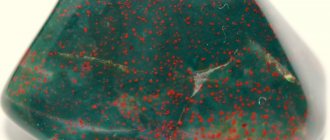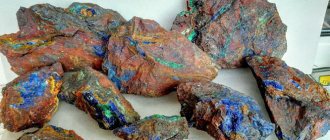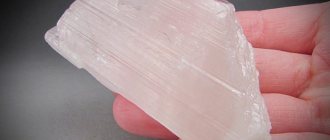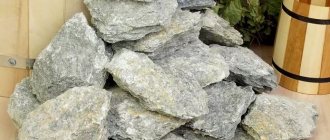Olivine belt
At the beginning of the last century, geophysics armed itself with sensitive instruments that detect the movements of the earth's crust deep in the bowels of the planet.
Having studied these fluctuations, scientists came to the conclusion that a huge ocean of viscous and liquid matter boils under the rocky surface of the Earth. No drilling machine can reach that deep yet. But it is still possible to study the contents of the underground “cauldron”. This substance - magma - is helpfully delivered to the surface by volcanoes.
According to geologists of the 20s of the last century, the Olivine Belt, consisting of a molten mix of minerals and metals, seethes several tens of kilometers under our feet. Olivine and gold predominate in this hellish mixture.
Writer Alexei Tolstoy used the Olivine Belt theory in the famous adventure novel “Engineer Garin’s Hyperboloid” (1927), where inventor-adventurer Pyotr Petrovich Garin pierces the earth’s crust with a ray of a fantastic hyperboloid, and becomes the richest man in the world.
A hundred years have passed, and geophysicists have a much clearer understanding of the structure of the Earth's internal structure. Now Tolstoy would hardly have enriched literature with his wonderful novel. Modern geophysicists have proven that there is no molten gold in the Olivine Belt. This heavy metal should sink well below the light olivine melt.
What does the Earth rest on?
But in other respects, Alexei Tolstoy was not mistaken. Olivine is indeed a common mineral. It composes the igneous rocks of the planet's mantle, on which the earth's firmament rests. Moreover, olivine is the basis or component of many other minerals and even precious stones (more on this in the chapter “Gem forms of olivine”). Therefore, geologists call olivine rock-forming .
The “godfather” of the mineral was the Swedish naturalist, professor at Uppsala University Johann Valerius. In his fundamental work “Mineralogy or description of all kinds of ores and minerals from the earth” (1747), the scientist proposed calling the yellow-green mineral, whose color resembles olives, olivine .
Rocks rich in olivine are a sure sign of deposits of diamonds, platinum, chromium, titanium, and nickel.
But olivine is also found on our planet and is of unearthly origin.
What is a mineral
Olivine is quartz, a silicate of the “island” subgroup (“islands” are inclusions in the crystal lattice):
- The concept of “olivine” implies a group of stones (11 names) of identical composition - with a formula of oxides of magnesium, iron and silicon in the composition.
- The description of a stone always includes color and saturation. They are created by compounds of nickel (yellow-brown) or chromium (green).
- The origin of the mineral is magmatic. In such rocks it occurs as small grains; crystals are rare.
The whole world was amazed by the rain of olivines that fell in Hawaii in the summer of 2018 after the eruption of a local volcano.
- The Mohs hardness of the mineral is above average, but the stone is fragile. The cleavage is imperfect, the fracture is conchoidal.
When interacting with sulfuric acid, the stone turns into a gelatinous mass. Even olivine, ground to powder, does not dissolve in salt water.
| Formula | (Mg,Fe)2[SiO4] |
| Impurity | Fe, Ni, Ca |
| Color | pale shades of green |
| Stroke color | white |
| Shine | glass |
| Transparency | transparent |
| Hardness | 6,5—7 |
| Kink | conchoidal |
| Density | 3.27—3.37 g/cm³ |
| singonia | rhombic |
Pallas iron
In 1749, the blacksmith and ore miner Yakov Medvedev became interested in an unusual iron nugget interspersed with green stone. He found this block of more than 40 pounds not far from a mining village, on the slopes of the Lesser Altai (now Krasnoyarsk Territory, Novoselovsky District, territory of the Komsky Village Council).
Medvedev dragged the nugget into the yard of the forge, and little by little he beat off pieces for crafts, marveling at the fact that the iron did not rust at all in the rains.
23 years later, the German naturalist and traveler Peter Pallas, academician of the St. Petersburg Imperial Academy of Sciences, visited these lands with a scientific expedition. Having examined the unique boulder, the scientist identified it as an alloy of olivine stone and native iron, and ordered it to be sent to the capital.
By the way, the Khakass, the indigenous inhabitants of these places, told Pallas that this boulder was a sacred stone, a gift from the gods, sent from heaven. But the German scientist considered such stories to be fiction.
This block, called Pallas's iron , was reported by Peter Pallas in publications of European scientific communities. Samples broken off from this strange olivine-iron formation were sent to the centers of science - Paris, Berlin, Vienna, London.
Compatibility with Zodiac signs
The main adherents of olivine are Pisces, Virgo and Leo:
- It will give unsure Pisces decisiveness and speed in making the right decisions, and smooth out possible conflict situations;
- for scrupulous Virgos it will add patience to others, reduce their slight tediousness, develop memory and intelligence, women will become more attractive;
- It will give royal Leos calmness in conflict situations, strength of spirit, sensitive intuition, and in the end they will get what they want - recognition from others.
Peridot favors 4 more signs:
- Libra - in family relationships;
- Taurus – in the midst of conflict, bestows compliance;
- Gemini - in difficult situations calms, lifts the mood;
- Aries - moderates ardor, imparts prudence.
For Sagittarius and Capricorn, the gem is neutral. It is not at all suitable only for Aquarius, Cancer and Scorpio.
No man is an island
And at the end of the 18th century, the German naturalist Ernst Florence Chladny, who studied one of these samples, published a book in which he for the first time scientifically substantiated the assumption that Pallas iron is a meteorite that formed in the depths of Space and once fell to Earth.
With this bold statement, he almost ruined his scientific career. Serious pundits refused to believe that stones could fall from the sky.
“What nonsense! Where would the huge boulders come from in the sky?” the skeptics asked with a grin.
It is interesting that, along with outstanding discoveries, the deepest ignorance reigned in the Paris Academy of Sciences. At a curious meeting that became famous (1772), French academics issued a thoughtful verdict: “Without any doubt, there cannot be flying stones in the sky. Consequently, any message that a stone fell from the sky is a deliberate lie.”
Meanwhile, even the Greek philosopher Diogenes (IV century BC) believed that meteorites are somehow connected with the stars, which means they are formed outside the Earth.
Pliny in “Natural History” (77 AD) wrote: “No one will doubt that stones often fall to the Earth.”
Time has put everything in its place, and now physicist Ernst Chladni is considered the founder of meteoritics , a science that built a bridge between geology and astronomy.
As for Pallas iron, the debate about its origin came to an end only in 1902, when a meteorite of a similar composition fell on the territory of Finland in the Marjalahti region. pallasites in modern mineralogy , and their contents are called pallasite . Olivine is probably one of the “building blocks” that makes up rocks on other planets.
Olivine group
This group includes silicates of type A2••[SiO4], where A=Mg, Fe, Mn, Ni, Co, Zn, Ca and Pb. All of them, with the exception of Ca and Pb, isomorphically replace each other in crystal lattices. The last two elements, due to the large size of their ionic radii, cause the formation of double compounds.
Rice. 278. Chemical composition of the main minerals of the olivine group
Forsterite
— Mg2SiO4. It is a pure magnesium member of the isomorphic series: Mg2SiO4-Fe2SiO4 (Fig. 278). Theoretical composition: MgO 57.1%, SiO2 42.9%.
singonia
rhombic: rhombo-bipyramidal c.
With. 3L23PC. The crystal structure
is discussed below (see olivine).
The appearance of crystals
. The crystals encountered have an isometric or slightly flattened appearance and represent a combination of the following shapes: {110}, {010}, {111} and {001}.
Color
.
Colorless; in aggregates light gray. Transparent. shine
, strong. Ng =1.670, Nm =1.651 and Np =1.635.
Hardness
7.
Cleavage
along {010} is noticeable.
Ud.
weight 3.217.
Diagnostic signs
. It is accurately determined in thin sections under a microscope by optical constants (refractive indices, birefringence and angle of optical axes). In the isomorphic series, forsterite-fayalite has the lowest specific gravity.
P. p. tr. doesn't melt. Insoluble in HCl. Powder in concentrated H2SO4 gives SiO2 jelly.
Origin
and
Deposits
. More often found in contact-metamorphic rocks (dolomite and limestone), for example in the area of st. Slyudyanka (Transbaikalia) in association with chondrodite and phlogopite, in the Nikolai-Maximilianovskaya mine in the Nazyamskie mountains (South Ural, Zlatoust region) among bluish coarse-grained marble with clinohumite, brucite, etc. There are known cases of forsterite formation due to serpentinized ultramafic rocks, for example in Snarume (Norway), in association with magnesite, phlogopite, hematite and spinel, apparently the result of processing under the influence of pneumatolytic agents under oxidizing conditions. Finds of forsterite with olivine in the ancient volcanic emissions of Vesuvius on Monte Somma, accompanied by spinel and augite, are also described.
Olivine
— (Mg,Fe)2SiO4. Named for its olive green color. Synonyms: chrysolite, peridot. "Chrysos" in Greek means gold. Olivine, essentially a ferruginous variety of forsterite (see Figure 278), is very widespread in nature as a rock-forming mineral in ultramafic igneous rocks.
Chemical composition
usually varies within the following limits (in%): MgO 50-45, FeO 8-12, less often up to 20, NiO 0.1-0.3, CoO up to 0.01; Manganese is sometimes present. Part of the iron is found in the oxide form (in partially serpentinized olivines).
singonia
rhombic; rhombo-bipyramidal c. With. 3L23PC.
Rice. 279. Crystal structure of olivine in projection onto the (100) plane. Black circles—silicon ions; large circles—oxygen ions; medium - magnesium ions
Crystal structure. The structure of olivine, according to Bragg and Brown, is shown in Figs 279 and 280 in projection onto the (100) plane. Its features boil down to the following:
- all oxygen ions are in a packing close to a hexagonal close packing, and within the unit cell they are located in two sheets parallel to (100); in Fig. 279 one sheet is shown as shaded circles;
- each Si ion is surrounded by four oxygen ions (isolated tetrahedral groups in Fig. 280 are outlined);
- Each Mg ion is surrounded by a sixfold environment of oxygen ions.
Rice. 280. The same in schematized form. The grid is built from separate blocks (A and B). The SiO4 tetrahedra alternately have their vertices directed up and down, and in different blocks they sit at different levels (the shaded tetrahedra are located relatively higher). Small circles indicate magnesium ions
Crystal Appearance
. Olivine is usually distributed in granular aggregates. Well-formed crystals in voids (or embedded in metamorphic rocks) are relatively rare. The most characteristic forms (Fig. 281): {100}, {110}, {010}, {111}, {001}, etc. Twins are rare, mostly in (011).
Figure 281. Olivine crystals
Color
olivine yellow with a greenish tint;
more often it is colorless, completely transparent; in partially serpentinized olivine rocks (dunites), it acquires a false green tint, due to serpentine developing metasomatically along cracks in olivine. shine
, greasy. Ng=l.68, Nm=1.66 and Np=1.64.
Hardness
6.5-7.
Fragile. Cleavage
is average or imperfect along {010}, less often along {100}.
The fracture is often conchoidal. Ud.
weight 3.3-3.5 (increases with increasing FeO content).
Diagnostic signs
. In olivine basalts, large disseminated grains of olivine are recognizable by their dark greenish-yellow color, glassy sheen, and uneven fracture. Intrusive olivine rocks are characterized by paragenesis with magnesian silicates (serpentine, pyroxenes) and chrome spinels.
P. p.tr. doesn't melt. Almost insoluble in HCl. The powder decomposes rapidly in concentrated H2SO4 to form SiO2 jelly.
Origin
.
The bulk of olivine is of igneous
origin. In mountainous regions, there are entire massifs of silica-poor igneous olivine rocks: 1) dunite, consisting almost entirely of olivine with an insignificant admixture of chrome spinels, and 2) peridotites, in which, in addition to olivine, pyroxenes are also present. True, in most cases the olivine in them has undergone serpentinization (a subsequent hydrothermal alteration process).
In addition, it is often a component of rocks such as gabbro, diabase, basalt and tuffs of basic volcanics. In quartz-containing, i.e., richer in silica, rocks, it is usually absent.
Quite large crystals and rounded pebbles of transparent olivine of a beautiful green or yellowish-green color (the so-called chrysolites) are found in the placers of Upper Egypt (east of Esne), India, Brazil and other places.
During weathering processes in olivine, oxidation of ferrous iron occurs, which is expressed in the browning of grains.
Practical significance
. Low-iron pure olivine rocks, unaltered or partially serpentinized, represent high-quality raw materials for the manufacture of refractory forsterite bricks. Since during their production under oxidative roasting conditions all the iron is separated in the form of magnetite, it is very important that the initial raw material contains a minimum amount of this element and that the MgO:SiO2 ratio is close to 2 (in molecular terms). Otherwise, during firing, along with forsterite, pyroxene, richer in silica, will be formed, which has less heat resistance. In order to compensate for the ferric oxide leaving the silicate part, an appropriate amount of magnesite is added to the fired mixture.
Transparent, beautifully colored and not affected by metamorphism, olivine crystals (peridots) are used as precious stones in jewelry.
Place of Birth
. Large massifs of olivine and olivine-pyroxene rocks, although mostly highly serpentinized, are distributed in various places of the Urals, the North Caucasus, Transcaucasia and along the southern outskirts of Siberia. Many of them are associated with deposits of chromium iron ore and sometimes platinum (Middle and Northern Urals). In ancient weathering crusts (Southern and Middle Urals), exogenous deposits of iron oxide ores and hydrosilicate nickel ores arose.
Fayalite
- Fe2SiO4. Faial is an island in the Azores archipelago, where this mineral was first found in the form of inclusions in blocks on the seashore. It is the final member of the isomorphic series forsterite - fayalite, as well as the series tephroite - fayalite (see Fig. 278).
Chemical composition
characterized by a sharp predominance of FeO. In purely ferruginous mineral form, the FeO content reaches 76%. The MgO content usually does not exceed several percent. It often contains MnO in larger quantities, sometimes ZnO. Along with FeO, Fe2O3 is sometimes contained, apparently as a product of partial oxidation.
singonia
rhombic;
rhombo-bipyramidal c. With. The appearance of crystals
. Rarely found crystals are similar in appearance to olivine crystals, sometimes tabular or short-prismatic.
Color
fayalite dark yellow to greenish-black;
oxidized varieties have a brownish-brown color. The luster
is glassy, strong, close to diamond. Ng =1.886, Nm =1.87/ and Np =1.835.
Hardness
6-6.5.
The cleavage
is clear along {010} and imperfect along {100}.
Ud.
weight 4.0-4.35.
P. p. tr. fused into black magnetic glass. Decomposes in HCl to release gelatinous silica.
Origin
and
Deposits
. It is found in crystal form in voids in obsidian (volcanic glass) in Yellowstone Park in the USA, on the Aeolian Islands and other places. As an extreme exception, fayalite (talaskite) - the mineral poorest in silica from the olivine group - was found in a vein of granite pegmatite in the form of large crystals, often surrounded by biotite, with microcline-perthite, albite, quartz and other minerals on the river bank. Jashi in the river basin Talas (Kyrgyz ridge). Fayalite is known in the form of continuous granular masses, for example, in the Mysovskoye deposit on the southern shore of Lake. Baikal.
Olivine from Space
Pallas iron has been identified throughout the world. Only in three rare cases was the fall of such an iron-stone meteorite observed. This happened on the island of Sicily (1826) and in Japan (1898). The third fall of pallasite was seen by the Finns in the mentioned region of Marjalahti.
The bulk of the pallasite fragments found belonged to meteorites that crashed onto the surface of our planet in the distant past.
In 1890, meteorite fragments interspersed with olivine were discovered near the town of Brenham (Kansas, USA). In total, more than 20 large fragments were collected, weighing about five tons. One of them, weighing 1,074 pounds (487 kg), is in the Natural History Museum in Chicago.
In 2005, meteorite hunters Steve Arnold and Phil Money explored the same area. Using metal detectors, they discovered and recovered several more large fragments of the meteorite from the ground.
An almost one and a half ton pallasite meteorite was found right on the pasture of a cattle farm near the city of Alice Springs, in northern Australia (1937).
Fragments of a meteorite weighing about a ton total were discovered in the Chilean Atacama Desert (1822).
In 2000, a farmer from the Chinese province of Xinjiang removed a huge boulder from his rice field, which turned out to be pallasite.
While digging a pit in the Gomel region (Belarus) in 2002, they found a fragment of a space guest (227 kg), buried three meters into the ground.
At various times, “Pallas iron” was found in the vast icy expanses of Antarctica.
How much does space pallasite cost?
The question is not at all idle. A pebble lying on the ground waiting for an attentive passerby can be more expensive than a gold bar.
Meteorites are coveted exhibits in collectors' collections. There is a particularly high demand for rare pallasites, although their cost is truly astronomical and is accessible to very few collectors - up to $40,000 per kilogram.
The thin polished sections of pallasite are especially beautiful. The bluish metal tightly frames the yellow-green crystalline formations of olivine. Such sections are reminiscent of artistic stained glass windows of avant-garde design.
However, there are meteorites that are more expensive. Fragments of completely inconspicuous-looking rocks that flew to Earth from Mars or the Moon can cost up to $10,000. Only not per kilogram, but per gram (5 carats). This cost is comparable to a good five-carat gem.
"Hawaiian Emeralds"
On the Hawaiian Islands (USA) there are colorful beaches made of various volcanic rocks crushed by the ocean surf.
Among them there is also grassy green. In Hawaiian it is called Papakolea. This section of the coast is strewn with green pebbles and sand rolled in by the waves. The olivine layers contained the slope of the Puu Mahana volcano that collapsed into the sea.
The water near the shore is also emerald green - the waves are saturated with small particles of the mineral olivine.
Depending on the lighting, the beach may change color several times during the day. In clear weather it is light olive, at dawn the shade of sand is grassy or yellow-green, as if covered with shoots of Irish heather. At sunset, the olivine grains of sand in your palm will resemble tiny emeralds and diamonds. Tourists call them that – Hawaiian emeralds.
How nice it is to swim in the emerald (literally!) sea, and then sunbathe on the mountains of treasures.
In fact, admiring travelers are not far from the truth - the beaches are strewn with billions of crystals of peridot, a gemstone that is part of a large family of minerals that include olivine in their structure.
Read the article “Chrysolite - evening emerald ”
But as soon as the sky becomes cloudy, the sand loses its magical green tint and turns into a dull dark gray strip between the surf and the steep slope of the volcano.
This is how olivine crystals in grains of sand refract sunlight.
Hawaii state authorities have banned the removal of olivine sand from a unique beach. Violating the law can result in a hefty fine. But tourists strive to take a handful as a souvenir.
The wayward surf is deaf to the ban. Sometimes storms wash thousands of tons of sand treasures into the ocean. Hawaiians fear that over time the precious olivine surface of the beach will disappear completely.
Colors and varieties
The name of the mineral comes from the olive fruit due to its characteristic color. Indeed, shades vary from light green with a golden tint to dark olive, brown and even gray. The color depends on the metal impurities in its composition.
A precious version of the mineral with a hint of gold in Greece and Russia has been called chrysolite for a long time (chrysos - gold, litos - stone). In France it is called peridot. The more nickel and chromium there are, the more intense the green. The darkest option is fayalite, forsterite is the lightest.
Other olivine beaches
There are several other green olivine beaches on the planet. One is located on the island of Guam in the western Pacific Ocean, in Micronesia. The island is part of the Mariana archipelago, famous for the fact that in the ocean next to it there is the deepest hole in the earth's crust - the Mariana Trench (11 km).
Here, green olivine, born in the volcano, is adjacent to dazzling white and orange sand from coral chips.
The Galapagos Islands, which belong to Ecuador, boast green beaches. The archipelago is located in the Pacific Ocean, a thousand kilometers from the coast of South America. The islands have active volcanoes that regularly supply olivine.
There is such an exotic beach in Europe, but there are few swimmers there. After all, the olivine beach is located in Norway, and is washed by the waves of the cold North Sea.
Gems of Olivine
Serpentine
Olivine that falls into the zone of hydrothermal vents is exposed to minerals dissolved in hot water, and also to weathering. So this stone is transformed into the mineral serpentine , reminiscent of snake skin. This similarity gave serpentine another name - serpentine .
The designs on serpentine are very diverse. Surprisingly, they are often similar to the shade and skin pattern of exactly those snakes that are found in the region of the mineral deposit. Scientists cannot explain such a mystical connection between living and inanimate nature.
Serpentine serpentine is used mainly as an ornamental stone.
Read the article “Serpentine - the stone of the Great Snake”
Chrysolite
We have already mentioned chrysolite. Let us add that this silicate changes color depending on the proportions of magnesium and iron it contains. It shows all shades of green - pistachio, yellowish, grassy, brown, golden.
In Russia, these semi-precious stones are mined in Yakutia.
Forsterite
Another variety of olivine is forsterite. This silicate contains magnesium, which is why forsterite is also called magnesium olivine.
It was first described in scientific literature by geologist Armand Levy (1824). The mineral is named after Jacob Forster, an English gemologist and mineral collector. Forsterite is found in volcanic deposits, for example, in the area of Mount Vesuvius (Italy).
The color of the mineral is traditionally green for olivines, but it can be white or lemon yellow. Gemologists classify transparent forsterite as semi-precious peridot.
Forsterite often accompanies deposits of spinel and serpentine, plagioclase and corundum.
Forsterite is a common mineral on Earth. There are about 800 of its deposits around the world. Forsterite samples were recovered from the bottom of the Pacific Ocean.
In Russia, there are forsterite deposits in the Urals.
In the electronics industry, forsterite ceramics are reliably soldered to metals in vacuum devices. The mineral, which has no jewelry value, is used to produce high-quality ceramic refractory materials.
Forsterite is found even in space. This ubiquitous mineral has been found on the Moon, in asteroids and comets, and in rocky meteorites that have fallen to Earth.
Peridot
Transparent green crystals of jewelry olivine are called peridot in Western mineralogy . Peridot crystals come in dark yellow, golden green,
The name probably comes from a similar ancient Greek word meaning “Giver of abundance.” These gems have been known to jewelers since time immemorial. Three thousand years ago, the ancient Egyptians mined peridot on the island of Zeberget in the Red Sea. This deposit has not been exhausted to this day.
Green peridot olivine is often very similar to emerald or chrysoberyl. The mineral often accompanies diamond deposits.
Some varieties of peridot have a "cat's eye" effect. Since ancient times, such stones have been considered a good amulet against the evil eye and magical spells.
Places of extraction and scope of application
Old olivine deposits have been discovered in the Red Sea on St. John's. The deposits on this island are almost exhausted, since the mineral has been mined for many centuries.
New large-scale deposits have been discovered in the United States, in the states of New Mexico and Arizona. A record-breaking crystal was discovered in Myanmar. Its weight was 200 carats.
In addition, olivine is mined in Brazil, Egypt, Australia, and Hawaii. In our country, rock deposits are located in Yakutia.
Due to its properties, the stone is widely used in various industries: agricultural, construction and jewelry.
Such noble species as peridot, peridot and serpentine are used for the production of jewelry.
Fire-resistant bricks are made from forsterite and then used in the construction of structures. And its crushed fragments become the basis for magnesium soil fertilizers.
Olivine, along with magmatic glass obsidian, is used for the production of technical silicates and glasses. You will find more about this breed in the article “Types and properties of obsidian stone.”
The magic of olivine
Magicians of the Eastern school have been using olivine for their rituals for thousands of years. The binary magical properties inherent in pallasites (metal-stone) that fell from Space are especially valued.
And terrestrial olivine is filled with energy not only from the underground, but also from the entire Universe. The magical properties of amulets made of cheerful green chrysolite are aimed at good luck in all the owner’s endeavors. It is recommended for those who have experienced a period of chronic failure in business.
Magic properties
The magical properties of olivine manifest themselves in everyday life:
- He will suggest a way to implement your plans (even plans bordering on fantasy). Will protect you from a rash, fatal option.
- Will create a “cocoon” against external negativity (from the evil eye to magical attacks).
- It will be easier for the owner of jewelry with olivine to establish business or friendly contacts.
- The significance of the stone as a guardian of the family hearth is great: it harmonizes the relationships of spouses and generations.
- In a house where there are olivines, fires are excluded.
An olivine talisman the color of money (that is, green) is needed if a streak of financial or business failures has begun.
However, the stone makes the owner highly moral and honest. If a person is not ready for this, it is better to look for another “helper”.
Peridot talismans are suitable for businessmen, scientists, musicians, and athletes.
For sorcerers, magicians, and esotericists, this is a means of communication with other worlds. Being a channel of communication with departed people is the main mission of the gem. Even an ordinary person who constantly wears an olivine ring will be able to “communicate.”
But more than two stones at a time are not used: this reduces their impact.

